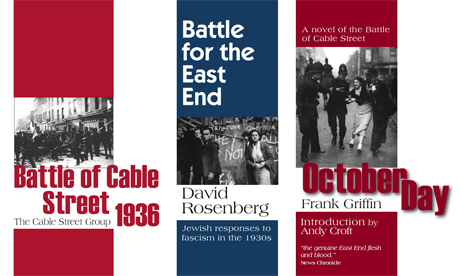East End histories: Cable Street books – review

Histories of Cable Street, published by Five Leaves
Unemployment is high and proposed cuts are causing deep rifts in a government also struggling to maintain the value of the pound abroad. As familiar as it might sound, the year is 1936. Against a backdrop of Depression, hunger marches and rising fascism on the Continent a number of fascist organisations pop up in Britain.
Amongst those playing to popular prejudice and blaming the country’s ills on immigrants and Jewish people, Oswald Mosley’s British Union of Fascists are particularly virulent. Emulating the fascist organisation Mosley had encountered in Italy, right down to their blackshirt uniform, the BUF’s activities were often violent.
During the summer of 1936, tensions rose as BUF activities increased and news that they were planning on marching through the East End in October was greeted with alarm. Sixty percent of Jews in London lived in the East and the march was a deliberate provocation, calculated to cause maximum confrontation and disruption.
After pleas for the march to be officially banned fell flat, the blackshirts assembled on 4 October, ready to march through Stepney. Anti-fascists rallied, uniting under the battle cry ¡No Pasaran! – they shall not pass, adopted from Spain’s own fight against fascism.
Despite the six thousand police attempting to clear the route, the anti-fascists stood strong, blocking the way. The only route left was through Cable Street, barricaded by protestors who chanted, blockaded the street with whatever they could find and fought running battles with the police. Eventually the BUF were forced back and the march dispersed to great jubilation.
The Battle of Cable Street, 1936 provides a thorough overview of the events. Born of a desire that this important piece of East London history is not forgotten, it was put together by the Cable Street Group and its reissue marks the 75th anniversary of the battle.
With black and white photographs and extracts from interviews with participants and witnesses it has been thoughtfully put together, capturing the heat and energy of the battle through the words of those who were there.
Everything Happens in Cable Street is an examination of the other stories the street has to tell, before and after its famous battle. A fascinating collection of local characters and places emerge from the pages of this well-researched book by long-term resident Roger Mills.
October Day follows the event of 4 October through the eyes of seven different people. Written by Frank Griffin, an eye-witness to the events, it offers a vivid insight into the people, the events and the politics.
These three very different books form an excellent record of an important historical event. Alive with defiance and solidarity, they make for essential reading, particularly by those who have begun to forget.
Everything Happens in Cable Street, by Roger Mills, October Day: A Novel of the Battle of Cable Street, by Frank Griffin and The Battle of Cable Street, by The Cable Street Group are all published by Five Leaves.
